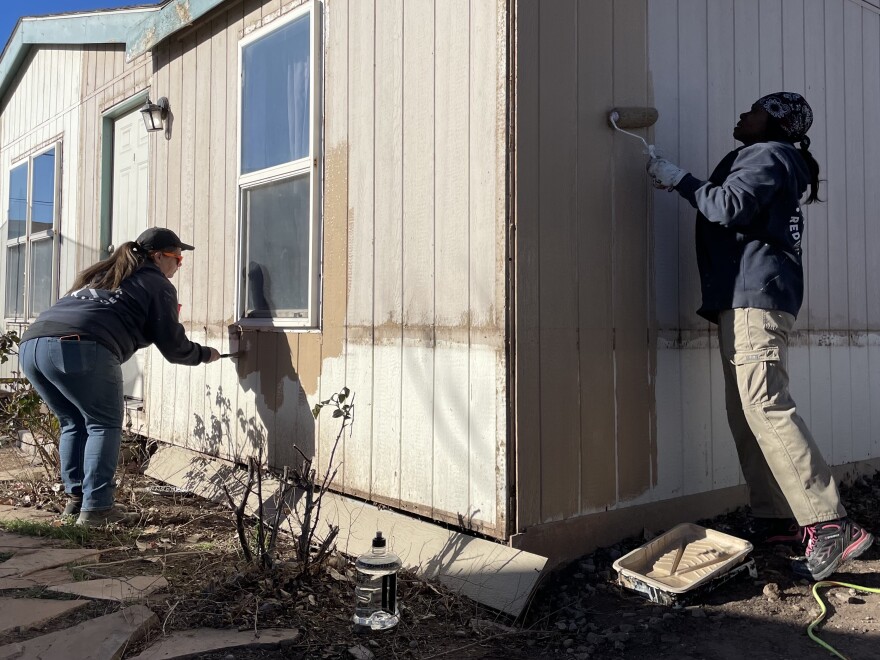It’s early on a Saturday morning, and a crew of employees and volunteers from the housing nonprofit Habitat for Humanity are loading up a truck with yard waste and unpacking their paint rollers.
“The two little girls that live in the house just came to the window and started waving to us,” said Heather Cunningham, the construction repair supervisor for the local chapter of Habitat. Her crew does retrofits, or fixes that will keep older adults and people with disabilities in their homes.
Today, they are at an older woman’s home, cleaning up a yard, fixing a patio and painting, so that her son and his family can move into the casita in the back.
“Paint is like the secret weapon of the house,” Cunningham said. “It's like a whole new house after you put paint on, so that's my favorite part.”

The owner is over 65 years old, and having her family nearby makes it easier for her to stay here as she ages. But she needed help with the work on the house.
“This type of work is a little difficult for her,” Cunningham said.
She said the Greater Albuquerque Habitat for Humanity started doing retrofits just a few years ago and averages about 50 per year. It funds them mostly through earnings from its home repair shop, but also receives federal funding.
They didn’t come up with the retrofit program on their own.
The country’s older adult population grew by about a third over the last decade, but housing that accommodates their needs hasn’t kept up. In response, government agencies and nonprofits are funding more retrofits in older adults’ homes.
The U.S. Departments of Housing and Urban Development and Agriculture each have a program. So do many state governments and several nonprofits that serve older adults.
Even though it’s not what Habitat for Humanity is known for, Housing Preservation Manager Jerry Zuniga said the newish program is taking off fast nationally.
“Owner-occupied repairs is Habitat’s largest body of work in terms of how many households we can reach in a year,” he said.
That can mean a lot of different kinds of work. Sometimes, they fix deterioration and safety issues, like at the house in Albuquerque. Other days, they’ll update heating and cooling systems to help lower bills, add a ramp, or make repairs after a natural disaster hits.
The program is primarily for low-income households, especially where older adults or people with disabilities live. Zuniga said the organization retrofits about 11,000 homes nationwide yearly, but the demand goes well past that.
“The housing stock is aging, and we know that housing plays a key role in the determinants of health for our community,” he said
Though the number is declining, about three quarters of older adults own their homes. Without the repairs, many would be at risk of injuries. A lot of people also don’t want to live in a nursing home or assisted living facility, and it’s hard to find a spot, especially for low-income families.
“We know a lot of that aging is in homeownership spaces,” Zuniga said. “The home is falling apart. We know there's investment needed there.”
But the work is expensive with inflation and growing labor costs, and the farther a crew needs to travel and move supplies, the higher the costs go. That makes it harder to pull off more projects in rural areas, where organization chapters usually receive fewer donations.
“Helping someone stay at home is complex, and having the home work for them is essential,” said Kathy Greenlee, who leads the Elder Justice Initiative at ADvancing States, a nonprofit organization that works with state governments to develop policies on aging.
Greenlee also said that beyond having a safe and accessible home, older adults also often need caretakers and access to health care. That can be one more barrier to this work helping rural communities.
She said these programs require more government support, too.
“What's a system that can help give it life, and how do we fund it so that it can get bigger?” she said.
The City of Albuquerque has a retrofit and safety update program that receives about $1 million in federal funding by way of New Mexico’s Aging and Long-Term Services Department and serves about 1500 people in Bernalillo County. It sometimes also works with Habitat for Humanity and other nonprofits.
Heather Cunningham with Habitat said the Albuquerque team is also expanding into Rio Rancho and working with other nonprofits.
“There's just a huge need all across the board for this type of work,” she said.
With the growing number of older adults, that’s not going to slow down anytime soon.
This coverage is made possible by the W.K. Kellogg Foundation and KUNM listeners.





